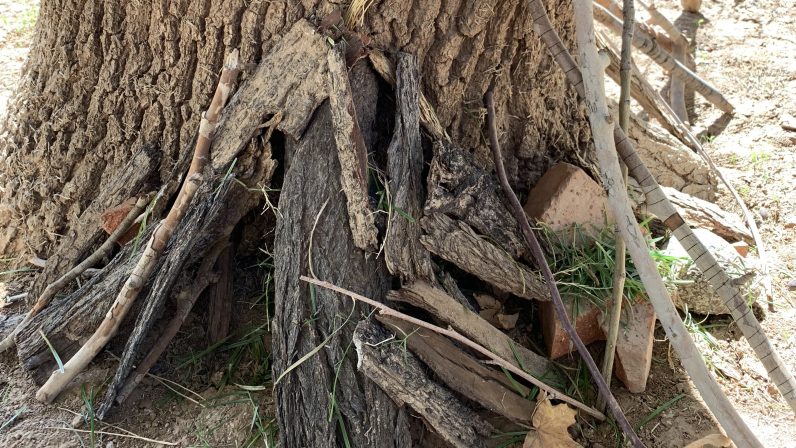Our first and second graders are currently developing the practice of using a writer’s notebook. Each week I present them with a different way to use their notebooks. This week I gave them a random photo of a scene from our playground. I invited them to look at their photo and see what it reminds them of, either on the Seed playground or in another aspect of their lives. As I distributed the photos, I deliberately handed the one of this stick construction to the girl who masterminded its creation a year ago. She lit up immediately when she saw the picture and wrote this story of her fairy house in her writer’s notebook: “I made a fairy house with my friend and me. It took a lot of sticks. It used a lot of leaves. It took rocks and logs. It was broken down the next morning and we were sad.” Clearly her memory of making this fairy house with a friend was still strong in her mind.
Another child, in response to a photo of pots in our sand circle, wrote this response: “This reminds me of me and my friend making dog food with pots and pans with soft sand and water. We put muddy dirt and clean dirt. We mixed it together. It also reminds me of me and my mom cooking blueberry bread because of the pots because it cooks in pots.”
In addition to fairy houses and making dog food with mud and sand, children are in a constant flow of creativity. They use bricks and logs to construct pirate ships that sail the seven seas. There is an endless stream of chefs stirring and mixing in the sand kitchen area. Gourmet dishes are offered to teachers and other students. Groups of children frequently hang off our repurposed tractors enroute to places like Disneyland and other interesting destinations. Furthermore, the fringes of the large grassy areas are consistently populated by fast moving variations of super heroes, good guys and bad guys, Ninja Turtles, and exotic princesses.
Having opportunities to express their creative imaginings is storytelling in action. Participating in story making this way gives children practice with creating plots, developing characters, and living the tensions within the story. Children collaborate on these stories, using their voices to express ideas with each other. They have to learn to work together, compromising so the story can continue. This play, inspired by various invitations on the playground, spills over into their classroom lives. Stories are told and retold, sometimes finding their way to the pages of a writer’s notebook. There’s a certain empowerment children experience when they are encouraged to develop their voices through play. Who knows how many works of art, written and visual, will trace their histories back to the Seed playground?

